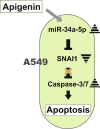miR-34a-5p might have an important role for inducing apoptosis by down-regulation of SNAI1 in apigenin-treated lung cancer cells
- PMID: 33675467
- PMCID: PMC8060201
- DOI: 10.1007/s11033-021-06255-7
miR-34a-5p might have an important role for inducing apoptosis by down-regulation of SNAI1 in apigenin-treated lung cancer cells
Abstract
Apigenin is a flavonoid with antioxidant and anticancer effects. It has been reported that apigenin inhibits proliferation, migration, and invasion and induces apoptosis in cultured lung cancer cells. However, there is little information on the involvement of microRNAs (miRNAs) in its effects. miRNA microarray analysis and polymerase-chain-reaction analysis of miRNAs revealed that treatment of human lung cancer A549 cells with apigenin up-regulated the level of miR-34a-5p. Furthermore, mRNA microarray analysis and the results of three microRNA target prediction tools showed that Snail Family Transcriptional Repressor 1 (SNAI1), which inhibits the induction of apoptosis, had its mRNA expression down-regulated in A549 cells treated with apigenin. Our findings suggest that apigenin might induce apoptosis by down-regulation of SNAI1 through up-regulation of miR-34a-5p in A549 cells.
Keywords: Apigenin; Apoptosis; Human lung cancer cell A549; SNAI1 (SNAIL); miR-34a-5p.
Conflict of interest statement
The authors declare no conflict of interest.
Figures




Similar articles
-
HMGB1 regulates SNAI1 during NSCLC metastasis, both directly, through transcriptional activation, and indirectly, in a RSF1-IT2-dependent manner.Mol Oncol. 2020 Jun;14(6):1348-1364. doi: 10.1002/1878-0261.12691. Epub 2020 May 6. Mol Oncol. 2020. PMID: 32306523 Free PMC article.
-
Luteolin Inhibits Tumorigenesis and Induces Apoptosis of Non-Small Cell Lung Cancer Cells via Regulation of MicroRNA-34a-5p.Int J Mol Sci. 2018 Feb 2;19(2):447. doi: 10.3390/ijms19020447. Int J Mol Sci. 2018. PMID: 29393891 Free PMC article.
-
MicroRNA-153-3p suppress cell proliferation and invasion by targeting SNAI1 in melanoma.Biochem Biophys Res Commun. 2017 May 20;487(1):140-145. doi: 10.1016/j.bbrc.2017.04.032. Epub 2017 Apr 8. Biochem Biophys Res Commun. 2017. PMID: 28400282
-
UBE2C, Directly Targeted by miR-548e-5p, Increases the Cellular Growth and Invasive Abilities of Cancer Cells Interacting with the EMT Marker Protein Zinc Finger E-box Binding Homeobox 1/2 in NSCLC.Theranostics. 2019 Mar 17;9(7):2036-2055. doi: 10.7150/thno.32738. eCollection 2019. Theranostics. 2019. Retraction in: Theranostics. 2020 Jul 25;10(21):9619. doi: 10.7150/thno.50254. PMID: 31037155 Free PMC article. Retracted.
-
Cytological effects of honokiol treatment and its potential mechanism of action in non-small cell lung cancer.Biomed Pharmacother. 2019 Sep;117:109058. doi: 10.1016/j.biopha.2019.109058. Epub 2019 Jun 5. Biomed Pharmacother. 2019. PMID: 31176168
Cited by
-
p53/MicroRNA-34 axis in cancer and beyond.Heliyon. 2023 Apr 3;9(4):e15155. doi: 10.1016/j.heliyon.2023.e15155. eCollection 2023 Apr. Heliyon. 2023. PMID: 37095919 Free PMC article. Review.
-
Peripheral Blood Genes Crosstalk between COVID-19 and Sepsis.Int J Mol Sci. 2023 Jan 30;24(3):2591. doi: 10.3390/ijms24032591. Int J Mol Sci. 2023. PMID: 36768914 Free PMC article.
-
The role of miR-16 and miR-34a family in the regulation of cancers: A review.Heliyon. 2025 Feb 17;11(4):e42733. doi: 10.1016/j.heliyon.2025.e42733. eCollection 2025 Feb 28. Heliyon. 2025. PMID: 40061926 Free PMC article. Review.
-
Long intergenic noncoding RNA for IGF2BP2 stability suppresses gastric cancer cell apoptosis by inhibiting the maturation of microRNA-34a.Open Med (Wars). 2024 Sep 27;19(1):20240992. doi: 10.1515/med-2024-0992. eCollection 2024. Open Med (Wars). 2024. PMID: 39381424 Free PMC article.
-
Influence of the Bioactive Diet Components on the Gene Expression Regulation.Nutrients. 2021 Oct 20;13(11):3673. doi: 10.3390/nu13113673. Nutrients. 2021. PMID: 34835928 Free PMC article. Review.
References
-
- Cao J, Chen W, Zhang Y, Zhang Y, Zhao X. Content of selected flavonoids in 100 edible vegetables and fruits. Food Sci Technol Res. 2010;16:395–402. doi: 10.3136/fstr.16.395. - DOI
MeSH terms
Substances
LinkOut - more resources
Full Text Sources
Other Literature Sources
Medical
Research Materials

